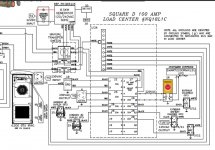#2 the shop test generator is being used to simulate our military customers 120/208 3 phase input power and there is no N to ground bond there. #3 if we meter N to ground, we have ~27V.
I believe if the there was a N to ground bond at the 3-phase shop test generator, then you'd see approximately 60V from N to ground. But with no N to ground bond in the system, the N-G voltage is dropping because only line-to-ground capacitances are establishing what that voltage will be.
I agree with zbang that the charger could be defective. It sounds like there could be a ground fault inside the charger. The charger's instructions recommend using a GFCI receptacle, so I'd plug the charger into a GFCI protected outlet and see if it trips or not.
I am thinking there is some issue with N to ground or with ground itself but do not have enough electrcial knoweldge to get to the root cause. TIA for any more insight.
I would expect that the military customer would want the trailer to operate from a 208/120V source that has a N to ground bond. But the buck boost transformers shown in the schematic provides no isolation and therefore the N to ground voltage will be approximately 60V, at least when there is little or no neutral current drawn from unbalanced 120V L-N loads across the two phases.
However, I think the separate neutral derived by the buck boost transformer arrangement will have a relatively high impedance, and therefore the voltages on the nominally 120V circuits would fluctuate significantly with unbalanced L-N loads. I think you should do additional testing with unequal loading across the two 120V phases. Start with a small 120V load and check the effect on the L-N voltages of both phases.
I believe the following on Larsen's web page does not adequately disclose the limitations of the neutral that's derived by its buck boost arrangement:
"This step-up transformer has a split phase secondary voltage of 120/240 V that generates a neutral and provides up to 46.88 amps at 240 V or two legs of 46.88 amps at 120 V for a total capacity of 93.76 A at 120 V on the secondary side."
There have some disclaimers later on, but they don't quantify any limitations there might be on the neutral current.
All of these issues seem to originate from a need to support 240V loads in addition to the 120V loads, because no transfomers would be needed if there were only 120V loads. As mentioned earlier in this thread, can you provide any more info on the 240V load that must be supported?


